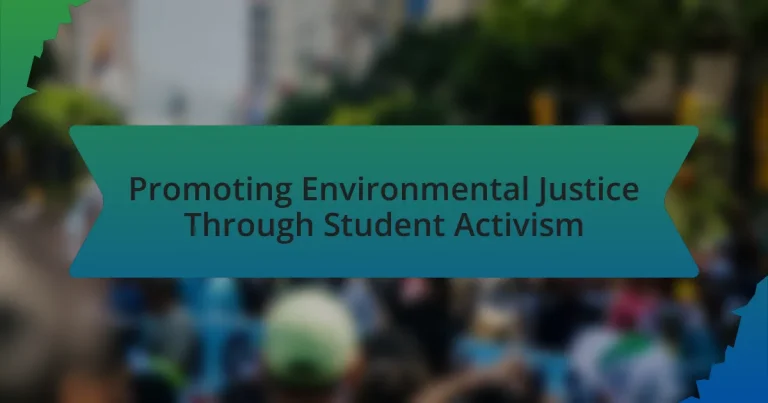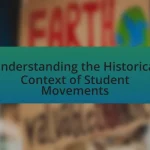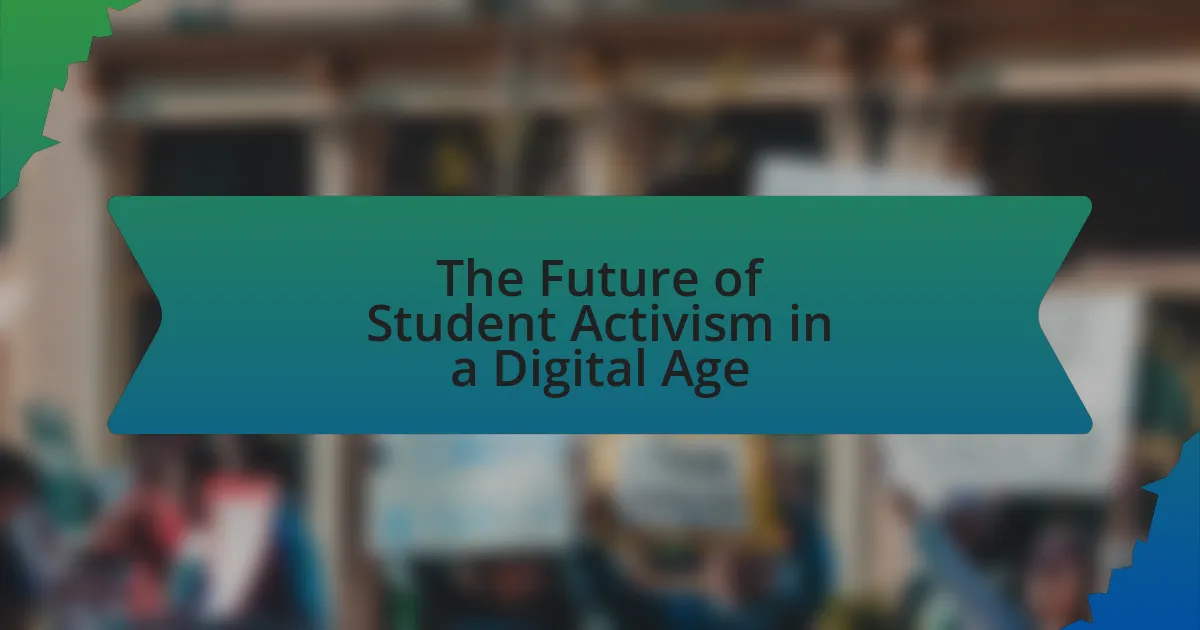The article focuses on promoting environmental justice through student activism, emphasizing the equitable distribution of environmental benefits and burdens, particularly for marginalized communities. It outlines the historical context of environmental justice movements, the relationship between environmental justice and social equity, and the challenges faced by student activists. Key strategies for advocacy, successful student-led initiatives, and the role of social media in amplifying their voices are discussed. The article highlights the importance of sustained engagement and intergenerational knowledge transfer in fostering effective activism for lasting change in environmental justice.
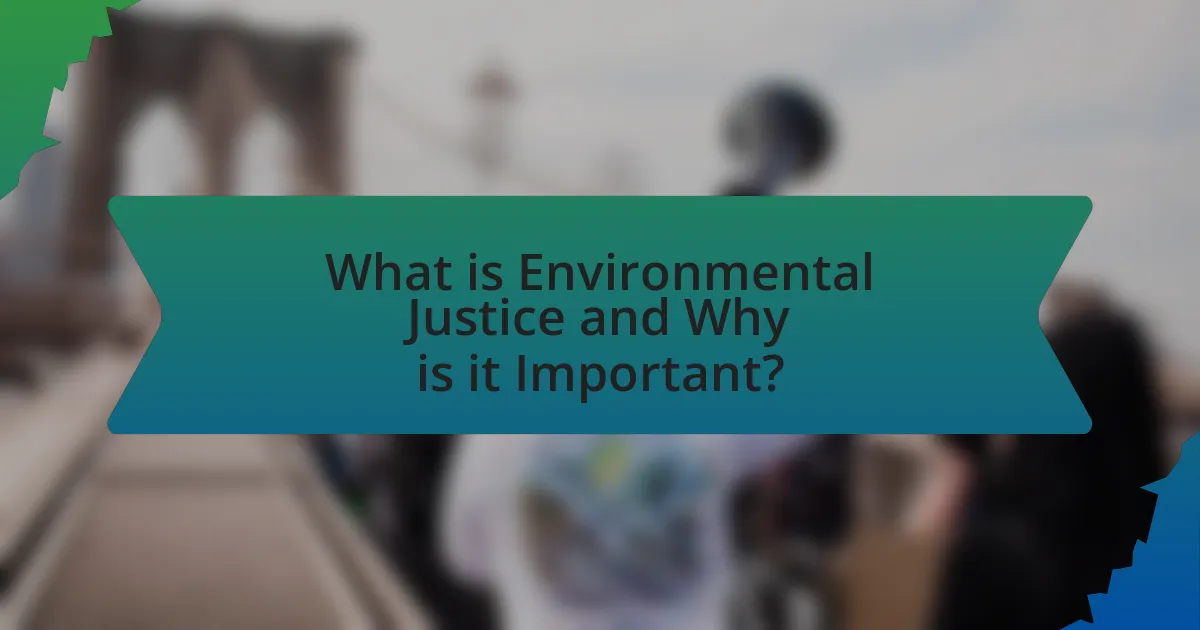
What is Environmental Justice and Why is it Important?
Environmental justice is the equitable distribution of environmental benefits and burdens, ensuring that all communities, particularly marginalized ones, have access to a healthy environment and are not disproportionately affected by environmental hazards. It is important because it addresses systemic inequalities that lead to environmental degradation in low-income and minority communities, as evidenced by studies showing that these populations often face higher exposure to pollutants and less access to clean resources. For instance, the U.S. Environmental Protection Agency reports that communities of color are more likely to live near hazardous waste sites, highlighting the urgent need for policies that promote environmental equity and protect vulnerable populations.
How does Environmental Justice relate to social equity?
Environmental Justice is intrinsically linked to social equity as it seeks to ensure that all individuals, regardless of their socioeconomic status, have equal access to a healthy environment and are not disproportionately affected by environmental hazards. This relationship is evident in the fact that marginalized communities often face greater exposure to pollution and environmental degradation, which exacerbates existing social inequalities. For instance, studies show that low-income neighborhoods and communities of color are more likely to be located near hazardous waste sites, leading to health disparities. Therefore, addressing environmental justice is essential for achieving social equity, as it aims to rectify these imbalances and promote fair treatment and meaningful involvement of all people in environmental decision-making processes.
What are the historical contexts of Environmental Justice movements?
Environmental Justice movements emerged in the late 20th century, primarily in response to the disproportionate environmental burdens faced by marginalized communities. The 1982 protests in Warren County, North Carolina, against a hazardous waste landfill marked a pivotal moment, highlighting the intersection of race, class, and environmental policy. This event catalyzed awareness and activism, leading to the 1991 First National People of Color Environmental Leadership Summit, which established key principles for environmental justice. These movements have since evolved, addressing systemic inequalities and advocating for equitable environmental policies, as evidenced by the establishment of the U.S. Environmental Protection Agency’s Office of Environmental Justice in 1994, which aimed to integrate environmental justice into federal decision-making processes.
How do marginalized communities experience environmental injustices?
Marginalized communities experience environmental injustices through disproportionate exposure to pollution, lack of access to clean resources, and inadequate representation in environmental decision-making. These communities often reside near hazardous waste sites, industrial facilities, and areas with high levels of environmental degradation, leading to adverse health outcomes such as respiratory diseases and higher rates of cancer. For instance, a study by the U.S. Environmental Protection Agency found that low-income and minority populations are more likely to live in areas with elevated levels of air pollution, which directly correlates with increased health risks. Additionally, these communities frequently lack the political power to influence policies that affect their environment, resulting in systemic neglect and further entrenchment of environmental disparities.
What role do students play in promoting Environmental Justice?
Students play a crucial role in promoting Environmental Justice by advocating for equitable environmental policies and raising awareness about environmental issues. Through organized activism, such as protests, campaigns, and educational initiatives, students mobilize communities to address the disproportionate impact of environmental hazards on marginalized populations. For instance, the Sunrise Movement, a youth-led organization, has successfully influenced climate policy discussions in the United States, demonstrating the power of student activism in shaping public discourse and policy. Additionally, research indicates that youth engagement in environmental issues leads to increased community involvement and policy changes, highlighting the effectiveness of student-led efforts in advancing Environmental Justice.
How can student activism influence policy changes?
Student activism can influence policy changes by mobilizing collective action and raising awareness about critical issues, particularly in the realm of environmental justice. For instance, student-led movements, such as the Sunrise Movement, have successfully pressured lawmakers to prioritize climate policies by organizing protests, engaging in lobbying efforts, and utilizing social media to amplify their messages. These actions have led to tangible outcomes, such as the introduction of the Green New Deal in Congress, which aims to address climate change and economic inequality. The effectiveness of student activism is further supported by research indicating that youth engagement in social movements can significantly impact public opinion and legislative agendas, as seen in various historical contexts, including the Civil Rights Movement and recent climate strikes.
What are some successful examples of student-led Environmental Justice initiatives?
Successful examples of student-led Environmental Justice initiatives include the Sunrise Movement, which mobilizes young people to advocate for climate action and policy changes, and the Zero Hour movement, which focuses on climate justice and youth activism. The Sunrise Movement has successfully influenced political discourse, leading to the introduction of the Green New Deal in Congress, while Zero Hour organized the first youth-led climate march in 2018, drawing thousands of participants and raising awareness about the intersection of climate change and social justice. These initiatives demonstrate the power of student activism in driving significant environmental policy changes and raising public awareness.
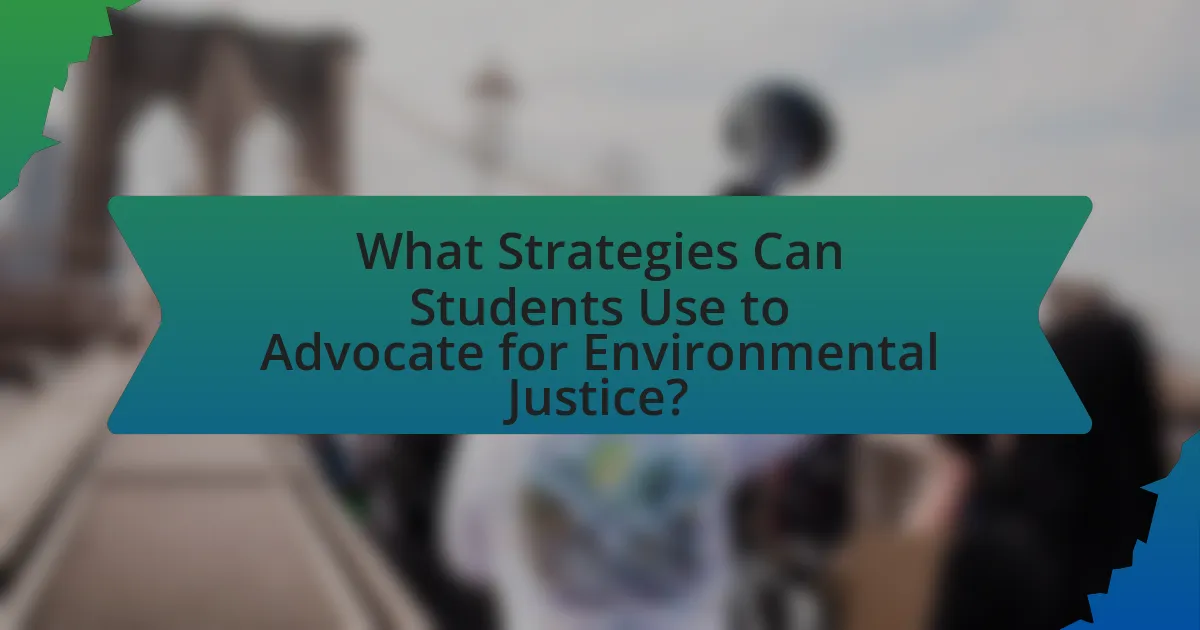
What Strategies Can Students Use to Advocate for Environmental Justice?
Students can advocate for environmental justice by organizing awareness campaigns, participating in community service projects, and engaging in policy advocacy. Organizing awareness campaigns allows students to educate peers and the community about environmental issues, fostering a collective understanding of the importance of environmental justice. Participating in community service projects, such as local clean-ups or tree planting, demonstrates commitment to improving the environment and can lead to tangible changes in local ecosystems. Engaging in policy advocacy, such as attending town hall meetings or lobbying local representatives, empowers students to influence legislation that addresses environmental injustices, as evidenced by the success of youth-led movements like the Sunrise Movement, which has effectively pushed for climate action policies.
How can students effectively organize and mobilize their peers?
Students can effectively organize and mobilize their peers by utilizing clear communication, establishing a shared vision, and leveraging social media platforms. Clear communication ensures that all members understand the goals and strategies of the initiative, while a shared vision fosters unity and motivation among peers. Social media platforms, such as Instagram and Twitter, can amplify their message, reach a broader audience, and facilitate coordination of events. For instance, the Sunrise Movement successfully mobilized thousands of young people for climate action by using social media to share information and organize protests, demonstrating the effectiveness of these strategies in promoting environmental justice.
What tools and platforms are available for student activism?
Tools and platforms available for student activism include social media networks, online petition sites, and collaborative project management tools. Social media platforms like Twitter, Instagram, and Facebook enable students to share information, mobilize support, and raise awareness about environmental issues quickly and broadly. Online petition sites such as Change.org and Care2 allow students to create and sign petitions, amplifying their voices and demands for change. Collaborative project management tools like Slack and Trello facilitate organization and communication among student groups, helping them coordinate efforts effectively. These tools have been instrumental in various successful student-led movements, demonstrating their effectiveness in promoting environmental justice.
How can students collaborate with local communities and organizations?
Students can collaborate with local communities and organizations by engaging in service-learning projects that address environmental issues. These projects often involve partnerships with local non-profits, government agencies, and community groups focused on sustainability and environmental justice. For example, students can participate in community clean-up events, tree planting initiatives, or educational workshops that raise awareness about environmental challenges. Research indicates that such collaborations enhance students’ understanding of real-world issues while benefiting the community, as seen in programs like the National Service-Learning Clearinghouse, which highlights successful student-community partnerships that promote civic engagement and environmental stewardship.
What are the challenges faced by student activists in Environmental Justice?
Student activists in Environmental Justice face several significant challenges, including limited resources, institutional resistance, and a lack of awareness among peers. Limited resources hinder their ability to organize events, conduct research, and mobilize support effectively. Institutional resistance often manifests in the form of bureaucratic hurdles or pushback from school administrations that may prioritize other agendas over environmental concerns. Additionally, a lack of awareness among peers can lead to difficulties in garnering support for initiatives, as many students may not fully understand the importance of environmental justice issues. These challenges collectively impede the effectiveness of student-led movements aimed at promoting environmental justice.
How can students overcome resistance from institutions or authorities?
Students can overcome resistance from institutions or authorities by employing strategic advocacy and coalition-building. Engaging in organized campaigns that highlight the importance of environmental justice can create a compelling narrative that resonates with broader societal values. For instance, successful student movements, such as the Sunrise Movement, have effectively mobilized support by framing climate action as a moral imperative, thereby pressuring institutions to respond. Additionally, forming alliances with faculty, community organizations, and other stakeholders amplifies their voice and increases the likelihood of institutional change. Research indicates that collective action, as demonstrated in studies on social movements, significantly enhances the effectiveness of advocacy efforts, leading to more substantial institutional responses.
What resources are available to support student activists?
Student activists can access various resources to support their initiatives, including organizations, funding opportunities, and educational materials. Organizations such as the Student Environmental Action Coalition (SEAC) provide networking, training, and advocacy support specifically for student-led environmental justice efforts. Additionally, grants from foundations like the Environmental Protection Agency (EPA) and the Sierra Club can offer financial assistance for projects aimed at promoting sustainability and environmental justice. Educational resources, including workshops and online courses from platforms like Coursera and local universities, equip student activists with the knowledge and skills necessary to effectively advocate for change. These resources collectively empower student activists to engage in meaningful environmental justice work.
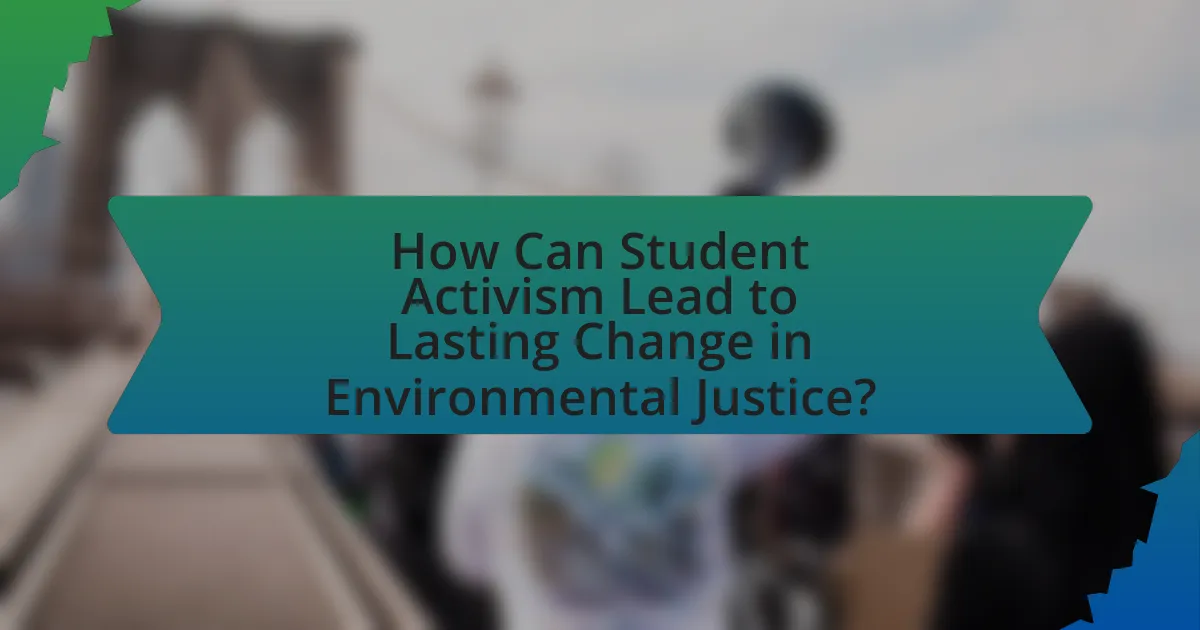
How Can Student Activism Lead to Lasting Change in Environmental Justice?
Student activism can lead to lasting change in environmental justice by mobilizing collective action, raising awareness, and influencing policy decisions. Through organized protests, campaigns, and educational initiatives, students can highlight environmental injustices faced by marginalized communities, thereby fostering public discourse and engagement. For instance, the Sunrise Movement, a youth-led organization, has successfully advocated for the Green New Deal, emphasizing the need for equitable climate policies. This activism not only pressures lawmakers to address environmental issues but also cultivates a generation of informed citizens committed to sustainability and social equity. Historical examples, such as the role of student protests in the anti-apartheid movement, demonstrate how youth-led efforts can reshape societal norms and policies, ultimately leading to systemic change in environmental justice.
What impact does student activism have on public awareness and education?
Student activism significantly enhances public awareness and education regarding social issues, particularly environmental justice. Through organized protests, campaigns, and educational initiatives, students effectively mobilize communities and draw attention to critical topics such as climate change, pollution, and sustainability. For instance, the global climate strikes initiated by students in 2019, inspired by Greta Thunberg, resulted in millions of participants worldwide, raising awareness about climate issues and influencing policy discussions. Research indicates that such activism not only informs the public but also encourages educational institutions to incorporate environmental justice into their curricula, fostering a more informed and engaged citizenry.
How can student-led campaigns create a ripple effect in society?
Student-led campaigns can create a ripple effect in society by mobilizing peers and communities around critical issues, leading to increased awareness and action. For instance, campaigns like the Sunrise Movement have successfully engaged young people in climate activism, resulting in broader societal discussions about environmental policies. This engagement often translates into tangible changes, such as local governments adopting more sustainable practices or educational institutions implementing eco-friendly initiatives. Research indicates that youth activism can significantly influence public opinion and policy, as seen in the 2019 Global Climate Strikes, where millions participated worldwide, demonstrating the power of collective student action in driving societal change.
What role does social media play in amplifying student voices?
Social media plays a crucial role in amplifying student voices by providing a platform for widespread communication and engagement. It enables students to share their perspectives, mobilize support, and raise awareness about environmental justice issues. For instance, movements like Fridays for Future have utilized platforms such as Twitter and Instagram to organize global climate strikes, reaching millions and influencing public discourse. Research indicates that social media can enhance civic engagement among youth, with 70% of young activists reporting that social media is essential for their activism efforts. This demonstrates the significant impact social media has in empowering students to advocate for change and connect with like-minded individuals.
What are some best practices for sustaining student activism in Environmental Justice?
To sustain student activism in Environmental Justice, it is essential to foster a strong sense of community and collaboration among students. Building networks through partnerships with local organizations and engaging in joint initiatives can amplify efforts and create a supportive environment. Research indicates that students who participate in collaborative projects are more likely to remain engaged over time, as seen in the findings of the “Youth Activism and Environmental Justice” study published in the Journal of Environmental Education, which highlights the importance of collective action in maintaining momentum. Additionally, providing educational resources and training on advocacy skills equips students with the tools necessary to effectively communicate their message and mobilize others. Regularly organizing events, workshops, and discussions keeps the momentum alive and encourages ongoing participation.
How can students maintain momentum after initial campaigns?
Students can maintain momentum after initial campaigns by establishing ongoing communication channels and creating a structured plan for future actions. Continuous engagement through social media, newsletters, or regular meetings keeps the community informed and motivated. Additionally, setting specific, measurable goals for subsequent campaigns helps maintain focus and accountability. Research indicates that organizations with clear objectives and regular updates see a 30% increase in participant retention and engagement. By fostering a sense of community and purpose, students can sustain their activism efforts effectively.
What strategies can ensure intergenerational knowledge transfer in activism?
Mentorship programs are effective strategies to ensure intergenerational knowledge transfer in activism. These programs facilitate direct relationships between experienced activists and younger individuals, allowing for the sharing of insights, experiences, and skills. Research indicates that mentorship enhances learning outcomes; for instance, a study by the National Mentoring Partnership found that mentored youth are 55% more likely to enroll in college and 78% more likely to volunteer regularly. Additionally, creating collaborative projects that involve both generations can foster mutual understanding and respect, as seen in initiatives like the Youth-Led Climate Action Network, which pairs young activists with seasoned leaders to address environmental issues. These strategies not only preserve historical knowledge but also empower the next generation to innovate and adapt activism to contemporary challenges.
